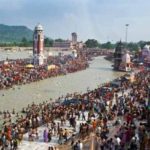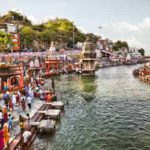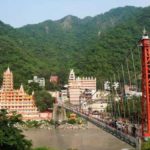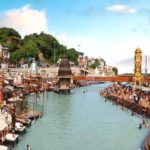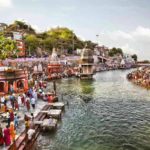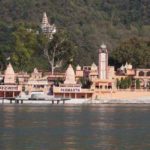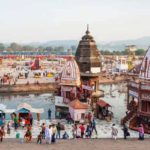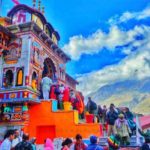Haridwar Kumbh Mela, the divine city of Uttarakhand, is one of the seven most holiest locations for Hindus in the whole of India. It is the venue where Maha-Kumbh will be held in 2021. ‘Haridwar’ simply means ‘Gateway to the land of God,’ and it is the place where the Ganga Holy River leaves the mountains and passes through God’s city. Every week, thousands of devotees come here to bathe in the holy waters and assemble around Har-Ki-Pauri for a ‘aarti‘ evening or prayer.
It was Bhagiratha in the Sata Yuga that carried Ganga to Earth to purify the souls of his cursed ancestors. He prayed to the goddess Ganga, the great river that will come to Earth, Who begged him, in exchange, to pray to the supreme god Shiva to make her appear on earth. Bhagiratha then prayed to Shiva, God, and begged him to help get the Ganga River to Earth.
It was here that Goddess River Ganga was released when the Supreme God Shiva opened the top ties/locks of his hair and allowed her to linger in them, according to a famous Hindu legend. From here, the Ganga River joined the Gangetic Plains at Haridwar for the first time after flowing 253 kilometers (157 miles) through the mountains from its source at ‘Gaumukh’ at the edge of the Gangotri Glacier, giving the region its primary name of ‘Gangadwar.’
‘Haridwar’ or ‘Haridwar Kumbh Mela’ is regarded as one of the Hindus’ seven holiest sites (Sapta Puri). Haridwar, along with Ujjain, Nashik, and Prayagraj (Allahabad), is one of 4 places, according to the Samudra Manthan, where a few drops of Amrit (the elixir of immortality) inadvertently spilled out of the pitcher while being borne by the Garuda Celestial Bird (Eagle). This is mirrored in the Kumbha Mela, celebrated in Haridwar every 12 years. Lakhs of monks, devotees, and visitors assemble in Haridwar during the Haridwar Kumbh Mela to conduct ‘the holy bath’ on the banks of the Ganga River to wash away their sins and achieve Moksha (Pittance).
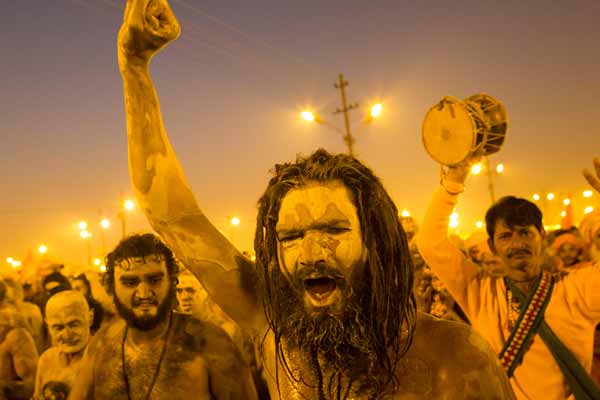
Har ki Pauri is one of the most popular sites in Haridwar, known as “Brahma Kund.” It is where a few drops of Amrit or an elixir of life have dropped, and that is why it is known as Haridwar’s most holy ghaat. It is also the epicenter of the ‘Kanwar pilgrimage’ in which participants’ lakhs obtain holy water from the Ganga River and take it over hundreds of miles to dispense it as an offering to ‘shiv lings’ in some of the temples of the most prominent God Shiva.
Hundreds of devotees assemble around Har Ki Pauri every evening to give River Goddess Ganga prayers by lighting up diyas and floating them in the river. The entry point of the River Ganga in Haridwar is marked by Har ki Pauri, which translates as “the footsteps of God Shiva.” Haridwar is also renowned for “Ganga Aarti,” which takes place at Har Ki Pauri Ghaat every evening and is attended by Har Ki Pauri Ghaat by hundreds of tourists every day.
As the number of devotees rises to thousands every day, as it is also the time of the holy bath and offering prayers to gods and goddesses, its significance during Kumbh increases. Sages or pandits deliver lighted lamps (diyas) during the ‘Ganga Aarti’ and sing Vedic mantras along with the ringing of bells to please the gods and goddesses for eternity and everything that are on earth.
Devotees may also recite mantras and give prayers along with the sages, who are dressed on their forehead in orange ‘dhoti’ and ‘chaadar’ with vermillion colored ‘tilak.’ It is said that during the Haridwar Kumbh Mela, those who engage in the “Ganga Aarti” remain rewarded in their lives by gods and enjoy good health, prosperity and remain safe from diseases.
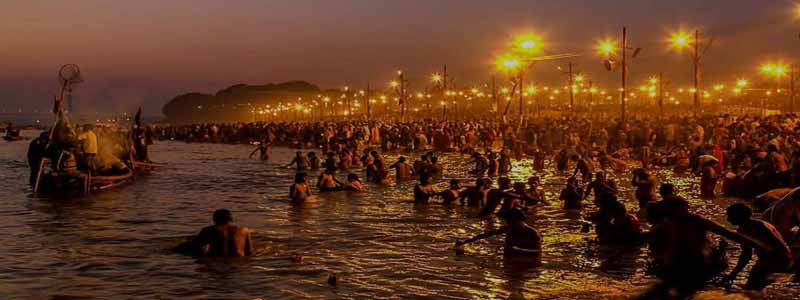
Haridwar Kumbh Mela Bathing Dates – 2021
The dates have been confirmed for the Kumbh Mela 2021 in Haridwar, attended by millions of pilgrims and devotees from India, as well as from around the world. It would be a momentous day, characterized by diverse practices, customs and ceremonies being performed. Mass eating, faith debates and devotional singing comprise these. The sharing of religious knowledge and scriptures takes place, while laymen follow devotees’ blessings. It has been included as a UNESCO Intangible Cultural Heritage because of the magnitude and scope of the occurrence.
Shahi Snan (royal bath) dates:
- March 11: First Shahi Snan on Maha Shivratri
- April 12: Second Shahi Snan on Somvati Amamvasya
- April 14: Third Shahi Snan on Baisakhi
- April 27: Fourth Shahi Snan on Chaitra Purnima
Other important holy bathing dates:
- January 14: Makar Sankranti
- February 11: Mauni Amavasya
- February 16: Basant Panchami
- February 27: Magh Poornima
- April 21: Ram Navami
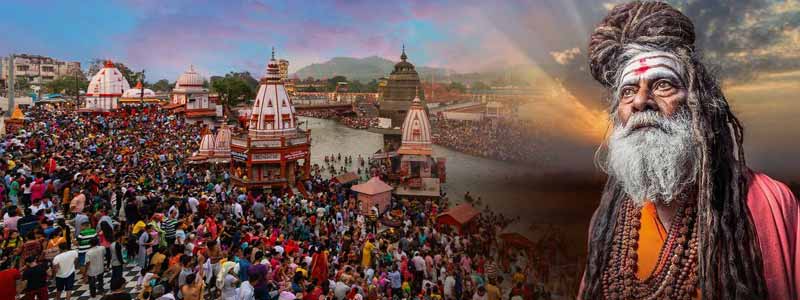
Tourist Attractions to See During Haridwar Kumbh Mela
During the Haridwar Kumbh Mela, millions of devotees gather. Take a dip in the holy water at Harki Pauri, offering prayers. You can also visit a number of the city’s attractions, which you can link to in the following list:
Har ki Pauri
Har-Ki-Pauri is visited in large numbers by devotees and tourists requesting the Holy Ganga’s blessings by offering their prayers. It is the place where, for the first time, the River Ganga flowing through the Himalayas reaches the plain and those who dip into the River Ganga will wash away all their sins. According to legend, the spot has a symbol of the footprint of Lord Vishnu on a stone that is even present today. This is why, during the Vedic era, it is assumed that Lord Shiva visited Har ki Pauri.
This holy Ghat, built by King Vikramaditya in memory of his brother Bhartrihari, who is thought to have come to Haridwar Kumbh Mela to meditate on the banks of the Ganga, is an enchanting sight to behold with a multitude of temples At the bank of the river and floating in the river with golden hues of floral diyas. The singing of mantras and prayers exudes divine vibes of sages meditating and is an experience of a lifetime. In the context, the sound of gongs brings us to a completely different setting.
Mansa Devi
The temple of Mansa Devi blesses the lives of those who visit there. Mansa Devi Temple, situated atop Bilwa Parvat, is renowned for being the house of Manasa, a form of Shakti believed to have arisen from Lord Shiva’s mind. The temple is one of the three Siddh Peethas, the other two being the temple of Chandi Devi and the temple of Maya Devi. ‘Wish’ is the literal sense of the word ‘Mansa’ and it is one of the locations Worship where expectations are satisfied.
Through connecting a string to neighboring branches of the temple, devotees may make a wish, and after their wishes are satisfied, they visit the temple again to untie the thread from the tree. Haridwar Kumbh Mela The temple contains two of Goddess Mansa’s principal statues, one with three mouths and five arms, while the other has eight arms.
You can either walk uphill to reach the main temple or hop on a cable car named “Mansa Devi Udankhatola” or a bus. The main attraction of the Mansa Devi Temple is a magnificent view of the River Ganga from a cable car.
Daksha Mahadev Temple
The Temple of Daksh Mahadev sits to the south of the town of Kankhal and is dedicated to Lord Shiva. This temple is named after King Daksh Prajapati, the father of Goddess Sati, Lord Shiva’s wife. Legend has it that there was a holy yajna (a fire ritual) once hosted by the king at this site. Because he did not invite Lord Shiva, however, Goddess Sati felt humiliated in his yajna and immolated herself. Out of rage, the ganas (followers of Lord Shiva) killed Daksh, the king.
Then Lord Shiva took him back to life and put a male goat’s head on him. The king later realized his error, and repented before the lord, who proclaimed that he would remain in Kankhal during the month of Saavan (June-August). The Sati Kund, on the banks of the Ganga River, is also considered sacred and the epic Mahabharata has been stated.
Chandi Devi
The Chandi Devi Temple is an important Haridwar pilgrimage centre. It is assumed that the temple’s principal deity was founded in the 8th century by Saint Adi Shankarcharaya. The temple of Chandi Devi is four kilometres from Haridwar and can be reached by hiking uphill or by cable car. The new temple construction was designed by Suchan Singh in 1929, who was then the reigning King of Kashmir.
One of the Siddhpeeth, along with Maya Devi and Mansa Devi, is the Chandi Devi Shrine. The temple, widely known as Neel Parvat Teerth, is also one of the five pilgrimage sites situated in Haridwar, Panch Tirth. The temple is located in the same location, according to mythology, where Chandi, the goddess born from the forces of the male deities, killed Chand-Mund, and then Shumbha and Nishumbha.
Maya Devi
A popular Haridwar tourist attraction is the Maya Devi Temple, one of the three Siddh Peetha and also referred to as Shakti Peetha. In worship of this god, Haridwar was also formerly known as the Mayapuri. Constructed in the 11th century, one of the three ancient temples of Haridwar, which is still intact, is also the Maya Devi Temple, two of which are Narayana-shila and Bhairava Temple. The statues of Goddess Maya, Goddess Kali, Goddess Kamakhya and two other goddesses, who are also forms of Shakti, are major attractions of the temple.
Goddess Maya, the temple’s principal deity, is a three-headed and four-arm deity and is thought to be Goddess Shakti’s manifestation. According to the Temple’s tales and history, Daksha, the father of Goddess Sati, offended her husband, God Shiva, and she set herself on fire to avenge the disrespectful actions of her father. When he heard of the death of his beloved, Lord Shiva was fiery with fury, and then he began a tour of the world bearing the body of Goddess Sati. While Shiva was holding Sati’s wife’s body, Goddess Sati’s navel and heart fall on the location of the current shrine. Between Navratri and Kumbh Fair, the best time to visit the Maya Devi temple.
Sapt Rishi
Sapt Rishi is one of Haridwar’s tourist spots and dates its history back to ancient times. Hindu mythology claims that this is where the Holy Ganga broke into seven waves to spare the seven Rishis any pain (Kashyapa, Vashist, Atri, Vishwamitra, Jamadagi, Bharadwaja and Gautam). It is surrounded by hundreds of mango trees that enhance the whole place’s beauty.
Frequently Asked Questions
Q: What is Kumbh Mela?
Ans: Kumbh Mela is a major pilgrimage of Hindus. It is the largest religious gathering of Hindus held four times over the course of 12 years at 4 different locations that are situated on the bank of the sacred rivers. Prayagraj (at the confluence of the Ganga, Yamuna and Saraswati Rivers), Ujjain (River Shipra), Haridwar (River Ganga) and Nasik (River Godavari) are the four destinations.
Q: Why is Kumbh Mela celebrated?
Ans: It is believed, the nectar from the pot fell at four locations – Prayagraj, Ujjain, Haridwar, and Nasik during an epic battle between the gods and the demons. At these four places, Kumbh Mela takes place. The Hindu devotees throng these places with a belief that a dip in the waters of the sacred rivers will wash away all their sins.
Q: What is Ardh Kumbh Mela?
Ans: The Ardh Kumbh Mela (Half Kumbh Mela) is held every 6 years in two different locations, Allahabad and Haridwar. Ardh means ‘half’ which is interpreted as the half of 12 years.
Q: What is Mahakumbh?
Ans: The Maha Kumbh Mela is held every 144 years at Prayagraj (Allahabad), after the completion of 12 Purna Kumbh Melas. The Purna Kumbh Mela is held every 12 years and hence, the Maha Kumbh Mela is held every 144 years (12*12=144).
Q: Why is Kumbh Mela held every 12 years?
Ans: The war between the gods and the demons over the possession of the Nectar of Immortality lasted for 12 divine days which are equivalent to 12 human years. Therefore, the Kumbh Mela or more commonly called Purna Kumbh Mela is held every 12 years at the 4 holy sites.
Q: In which places is the Kumbh Mela celebrated?
Ans: The Kumbh Mela is held in Prayagraj (at the confluence of Ganga, Yamuna and Saraswati Rivers), Nasik (River Godavari), Ujjain (River Shipra) and Haridwar (River Ganga).
Q: When will the next Kumbh Mela be held?
Ans: The next Kumbh Mela will be held at Haridwar in 2021. The Kumbh Mela in Haridwar in 2021 will begin on 14th January, while the first Shahi Snan will take place on 11th March. The last Shahi Snan will take place on 14th April, marking the end of the Haridwar Kumbh Mela.
Q: What is the religious significance of Kumbh Mela for devotees of Hinduism?
Ans: The Hindu devotees believe that a visit to the auspicious Kumbh Mela and a dip in the river will cleanse them from all their sins.
Q: What are the main attractions of Kumbh Mela?
Ans: The major attractions of the Kumbh Mela are: a holy bath in the sacred river that is believed to cleanse one from all their sins; the sacred Aartis on the banks of the river accompanied by the prayers and hymns chanted by the priests, the Pravachan, Kirtan, Mahaprasad and the Naga Sadhus.

